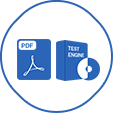Last Update 18 hours ago Total Questions : 730
The Data Management Fundamentals content is now fully updated, with all current exam questions added 18 hours ago. Deciding to include DMF-1220 practice exam questions in your study plan goes far beyond basic test preparation.
You'll find that our DMF-1220 exam questions frequently feature detailed scenarios and practical problem-solving exercises that directly mirror industry challenges. Engaging with these DMF-1220 sample sets allows you to effectively manage your time and pace yourself, giving you the ability to finish any Data Management Fundamentals practice test comfortably within the allotted time.
Logical abstraction entities become separate objects in the physical database design using one of two methods.
Typically, DW/BI projects have three concurrent development tracks, including:
The accepted tenets of bioethics provide a starting point for the principles of data ethics. Which of the following tenets of bioethics is NOT included in the DMBOK2 Chapter on Data Handling Ethics?
Your organization has many employees with official roles as data stewards and data custodians, but they don't seem to know exactly what they're supposed to be doing. Which of the following is most likely to be a root cause of this problem?
Developing complex event processing solutions require:
Orchestration is the term used to describe how multiple processes are organized and executed in a system.
Machine learning explores the construction and study of learning algorithms.
What is the best reason for capturing synonyms in a data repository?
All data is of equal importance. Data quality management efforts should be spread between all the data in the organization.
Data quality management is a key capability of a data management practice and organization.
ETL is the basic process which is central to all areas in Data Integration and Interoperability. It is an abbreviation for extract, transition and load.
Data warehousing describes the operational extract, cleaning, transformation, control and load processes that maintain the data in a data warehouse.

